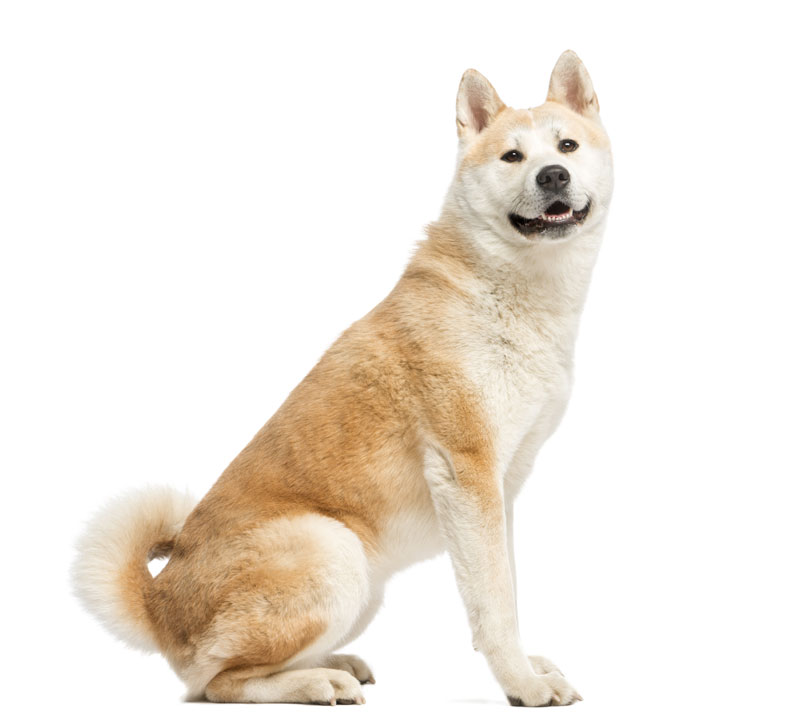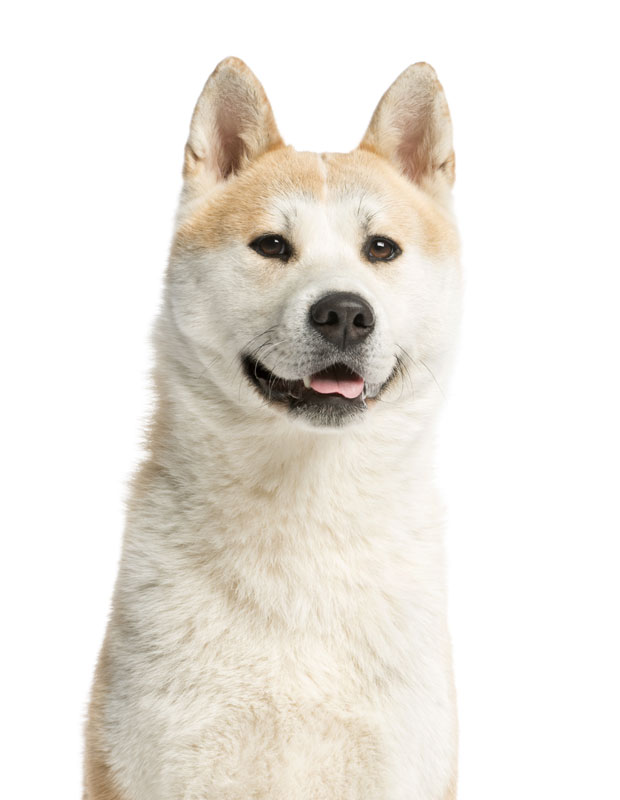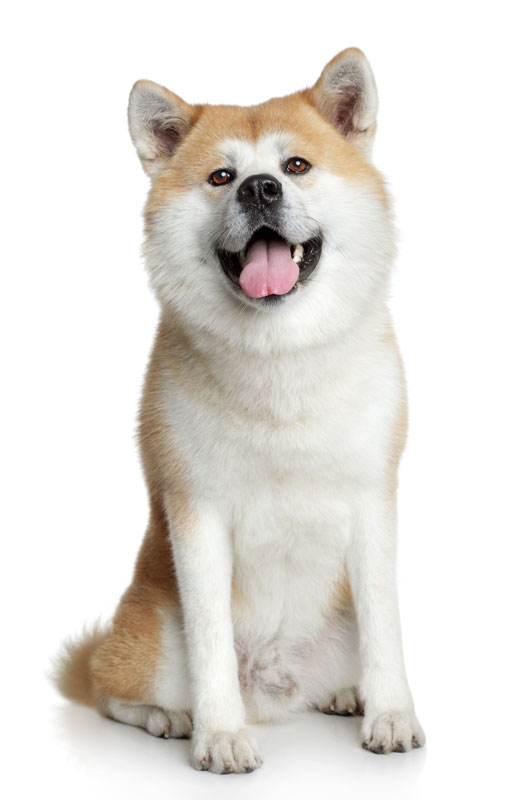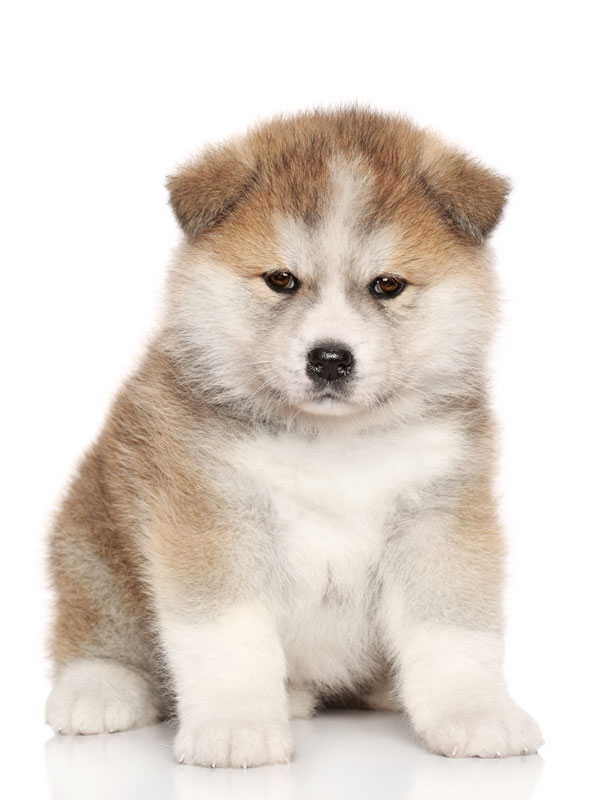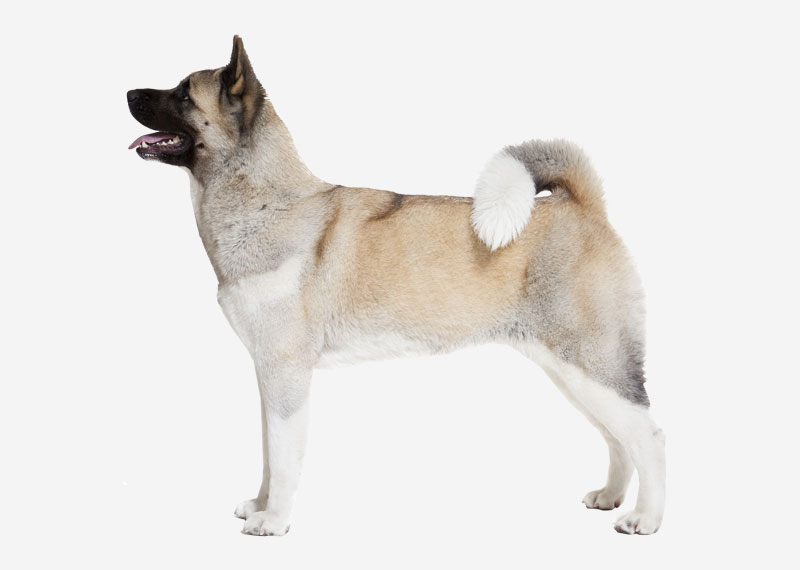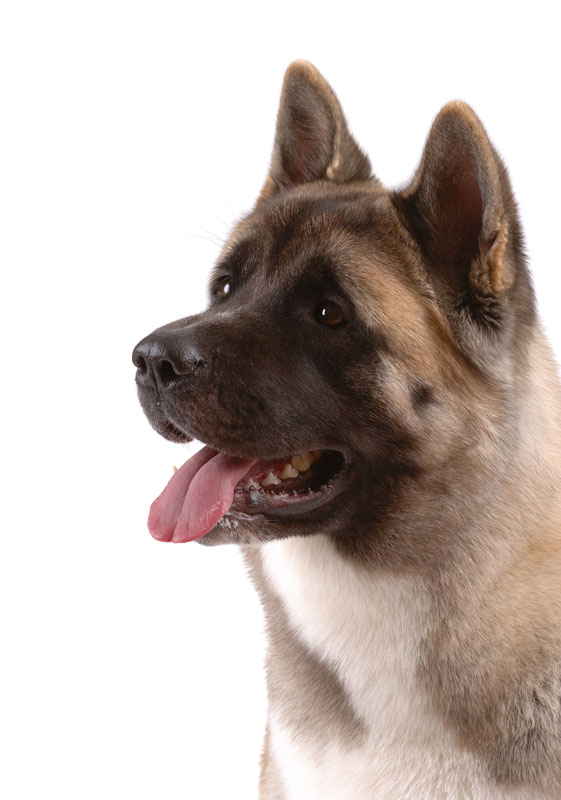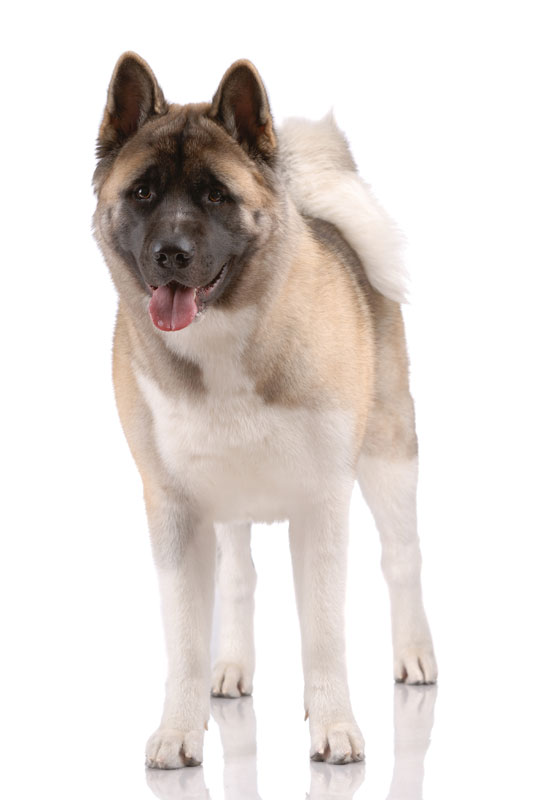The Akita (秋田犬 Akita-inu) is a large breed of dog originating from the mountainous northern regions of Japan. There are two separate varieties of Akita: a Japanese strain, known as the "Akita Inu" or "Japanese Akita"; and an American strain, known as the "Akita" or "American Akita". The Japanese strain comes in a small choice of colors, with all other colors considered atypical of the breed, while the American strain comes in all dog colors. The Akita has a short double coat, similar to that of many other northern spitz breeds such as the Siberian Husky, but long coated dogs can be found in many litters due to a recessive gene.
The Akita is a powerful, independent and dominant breed, commonly aloof with strangers but affectionate with family members. As a breed, Akitas are generally hardy, but they have been known to suffer from various genetic conditions and be sensitive to certain drugs.
In most countries, the American strain of Akita is now considered a separate breed. In the United States and Canada, however, the two strains are considered a single breed with differences in type. For a while, the American strain of Akita was known in some countries as the "Great Japanese Dog". Both forms of Akita are probably best known worldwide from the true story of Hachikō, a loyal Akita who lived in Japan before World War II.
History
Japanese history
Japanese history, both verbal and written, describe the ancestors of the Akita, the Matagi dog (Japanese:マタギ犬)(hunting dog, Bear hunting dog, Deer hunting dog), as one of the oldest of the native dogs. Today's Akita developed primarily from dogs in the northernmost region of the island of Honshū in the Akita prefecture, thus providing the breed's name. The Matagi's quarry included wild boar, Sika deer, and Asian black bear. This precursor dog tracked large game, holding it at bay until hunters arrived to make the kill. The breed is also influenced by crosses with larger breeds from Asia and Europe, including English Mastiffs, Great Danes, St. Bernards and the Tosa Inu, in the desire to develop a fighting dog for the burgeoning dog fighting industry in Odate in the early 20th century. During World War II the Akita was also crossed with German Shepherd Dogs in an attempt to save them from the war time government order for all non-military dogs to be culled. The ancestors of the American Akita were originally a variety of the Japanese Akita, a form that was not desired in Japan due to the markings, and which is not eligible for show competition.
The story of Hachikō, the most revered Akita of all time, helped push the Akita into the international dog world. Hachiko was born in 1923 and owned by Professor Hidesaburō Ueno of Tokyo. Professor Ueno lived near the Shibuya Train Station in a suburb of the city and commuted to work every day on the train. Hachikō accompanied his master to and from the station each day. On May 25, 1925, when the dog was 18 months old, he waited for his master's arrival on the four o'clock train, but Professor Ueno had suffered a fatal brain haemorrhage at work. Hachikō continued to wait for his master's return. He travelled to and from the station each day for the next nine years. He allowed the professor's relatives to care for him, but he never gave up the vigil at the station for his master. His vigil became world renowned when, in 1934, shortly before his death, a bronze statue was erected at the Shibuya train station in his honor. This statue was melted down for munitions during the war and new one was commissioned once the war ended. Each year on April 8 since 1936, Hachikō's devotion has been honoured with a solemn ceremony of remembrance at Tokyo's Shibuya railroad station. Eventually, Hachikō's legendary faithfulness became a national symbol of loyalty, particularly to the person and institution of the Emperor.
In 1931, the Akita was officially declared a Japanese Natural Monument. The Mayor of Odate City in Akita Prefecture organized the Akita Inu Hozankai to preserve the original Akita as a Japanese natural treasure through careful breeding. In 1934 the first Japanese breed standard for the Akita Inu was listed, following the breeds declaration as a natural monument of Japan. In 1967, commemorating the 50th anniversary of the founding of the Akita Dog Preservation Society, the Akita Dog Museum was built to house information, documents and photos.
In 1937, Helen Keller travelled to Japan. She expressed a keen interest in the breed and was presented with the first two Akitas to enter the US. The first dog, presented to her by Mr. Ogasawara and named Kamikaze-go, died at five months of age from distemper, one month after her return to the States. A second Akita was arranged to be sent to Miss Keller: Kamikaze's litter brother, Kenzan-go. Kenzan-go died in the mid-1940s. By 1939 a breed standard had been established and dog shows had been held, but such activities stopped after World War II began. Keller wrote in the Akita Journal:
| “ | If ever there was an angel in fur, it was Kamikaze. I know I shall never feel quite the same tenderness for any other pet. The Akita dog has all the qualities that appeal to me — he is gentle, companionable and trusty. | ” |
Just as the breed was stabilizing in its native land, World War II pushed the Akita to the brink of extinction. Early in the war the dogs suffered from lack of nutritious food. Then many were killed to be eaten by the starving populace, and their pelts were used as clothing. Finally, the government ordered all remaining dogs to be killed on sight to prevent the spread of disease. The only way concerned owners could save their beloved Akitas was to turn them loose in remote mountain areas, where they bred back with their ancestor dogs, the Matagi, or conceal them from authorities by means of crossing with German Shepherd dogs, and naming them in the style of German Shepherd dogs of the time. Morie Sawataishi and his efforts to breed the Akita is a major reason this breed exists today.
During the occupation years following the war, the breed began to thrive again through the efforts of Sawataishi and others. For the first time, Akitas were bred for a standardized appearance. Akita fanciers in Japan began gathering and exhibiting the remaining Akitas and producing litters in order to restore the breed to sustainable numbers and to accentuate the original characteristics of the breed muddied by crosses to other breeds. U.S. servicemen fell in love with the Akita and imported many with them upon their return.
The Japanese Akita and American Akita began to diverge in type during the Post–World War II era. It was during this time, that US servicemen serving as part of the occupation force in Japan first came into contact with the Akita, the breed so impressed them that many soldiers chose to bring an Akita back home with them upon completion of their tour. American soldiers were typically more impressed with the larger more bear-like fighting Akita or German Shepherd type than they were with the smaller framed and fox-like Akita-Inu; the types of dogs they brought back with them to the US reflected this sentiment. Japanese Akita fanciers focused on restoring the breed as a work of Japanese art or to 'Natural Monument' status. American Akita fanciers chose to breed larger, heavier-boned and more intimidating dogs. Although, both types derive from a common ancestry, there are marked differences between the two. First, while American Akitas are acceptable in all colors, Japanese Akitas are only permitted to be red, fawn, sesame, white, or brindle.Additionally, American Akitas may be pinto and/or have black masks, unlike Japanese Akitas where it is considered a disqualification and not permitted in the breed standards. American Akitas generally are heavier boned and larger, with a more bear-like head, whereas Japanese Akitas tend to be lighter and more finely featured with a fox-like head.
Recognized by the American Kennel Club in 1955, it was placed in the Miscellaneous class. It was not until the end of 1972 that the AKC approved the Akita standard and it was moved to the Working dog class, as such, the Akita is a rather new breed in the United States. Foundation stock in America continued to be imported from Japan until 1974 when the AKC cut off registration to any further Japanese imports until 1992 when it recognized the Japan Kennel Club. The decision by the AKC to disallow the registration of any further imported dogs in 1974, set the stage for the divergence in type between the American Akita and Japanese Akita Inu that is present today.
Elsewhere in the world, the American Akita was first introduced to the UK in 1937, he was a Canadian import, owned by a Mrs. Jenson, however the breed was not widely known until the early 1980s. The breed was introduced in Australia in 1982 with an American Import and to New Zealand in 1986 with an import from the U.K.
Autoimmune diseases
There are many autoimmune diseases that are known to sometimes occur in the Akita. These include, but are not limited to:
- Vogt-Koyanagi-Harada syndrome, also known as Uveo-Dermatologic Syndrome is an auto-immune condition which affects the skin and eyes.
- Autoimmune Hemolytic Anemia, which is an autoimmune blood disorder.
- Sebaceous Adenitis is an autoimmune skin disorder believed to be of autosomal recessive inheritance.
- Pemphigus Foliaceus is an autoimmune skin disorder, believed to be genetic.
- Systemic Lupus Erythematosus also known as SLE or lupus, is a systemic autoimmune disease (or autoimmune connective tissue disease) that can affect any part of the body.
Immune-mediated endocrine diseases
In addition to these there are also the Immune-mediated endocrine diseases with a heritable factor, such as:
- Addison’s Disease also known as hypoadrenocorticism, it affects the adrenal glands and is essentially the opposite to Cushing's syndrome.
- Cushing’s Syndrome also known as Hyperadrenocorticism, it affects the adrenal glands and is caused by long-term exposure to high levels of glucocorticosteroids, either manufactured by the body or given as medications.
- Diabetes mellitus also known as type 1 diabetes. It affects the pancreas.
- Hypothyroidism, also known as autoimmune hypothyroidism. This is an autoimmune disease which affects the thyroid gland.
Non immune specific conditions
Other non-immune specific conditions known to have occurred in the Akita include:
- Gastric Dilation is also known as bloat; may progressive to gastric dilation-voluvulus (GDV, also called gastric torsion), in which the stomach twists on itself.
- Microphthalmia, meaning "small eyes", is a developmental disorder of the eye, believed to be an autosomal recessive genetic condition.
- Primary Glaucoma, Increased pressure in the eye.
- Progressive Retinal Atrophy progressive degeneration of the retina (portion of the eye that senses light and allows sight).
- Hip dysplasia a skeletal condition where the head of the femur does not fit properly into the hip socket. Leads to osteoarthritis and pain.
- Elbow dysplasia a skeletal condition in which the components of the elbow joint (the humerus, radius, and ulna) do not line up properly, leading to osteoarthritis and pain.
- Von Willebrands Disease, a genetic bleeding disorder caused by a deficiency in Von Willebrand factor.
Breed specific conditions
There are two breed specific conditions mentioned in veterinary literature:
- Immune Sensitivity to vaccines, drugs, insecticides, anesthetics and tranquilizers
- Pseudohyperkalemia, a rise in the amount of potassium that occurs due to its excessive leakage from red blood cells (RBCs) when blood is drawn. This can give a false indication of hyperkalemia on lab tests, hence the prefix pseudo, meaning false. This occurs because many eastern Asian breeds, including Akitas and Shiba Inus, have a higher level of potassium in their RBCs than other dogs.


